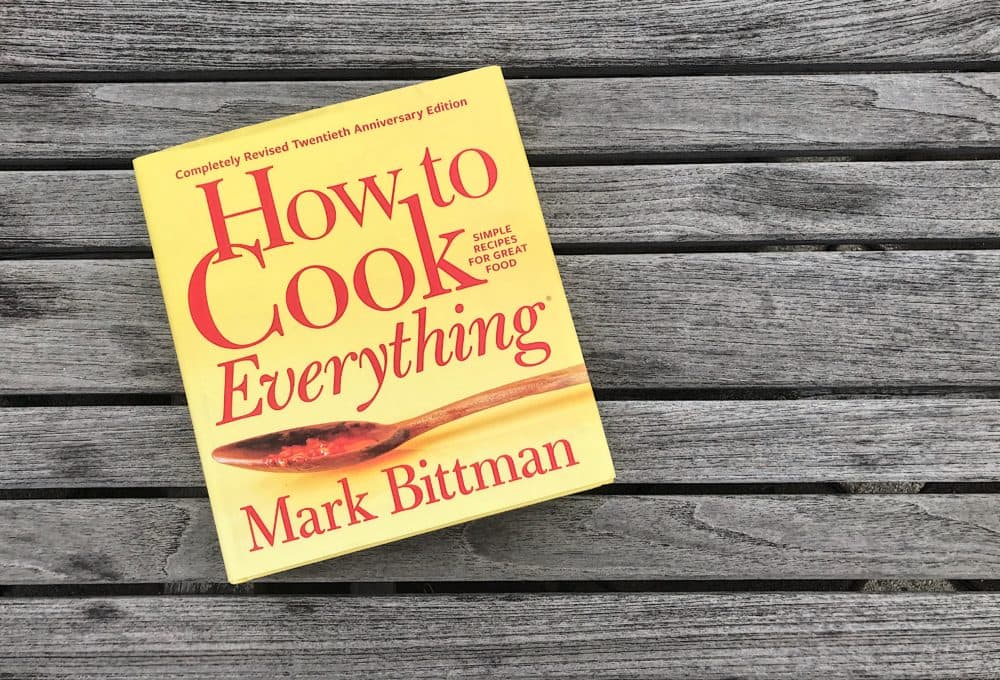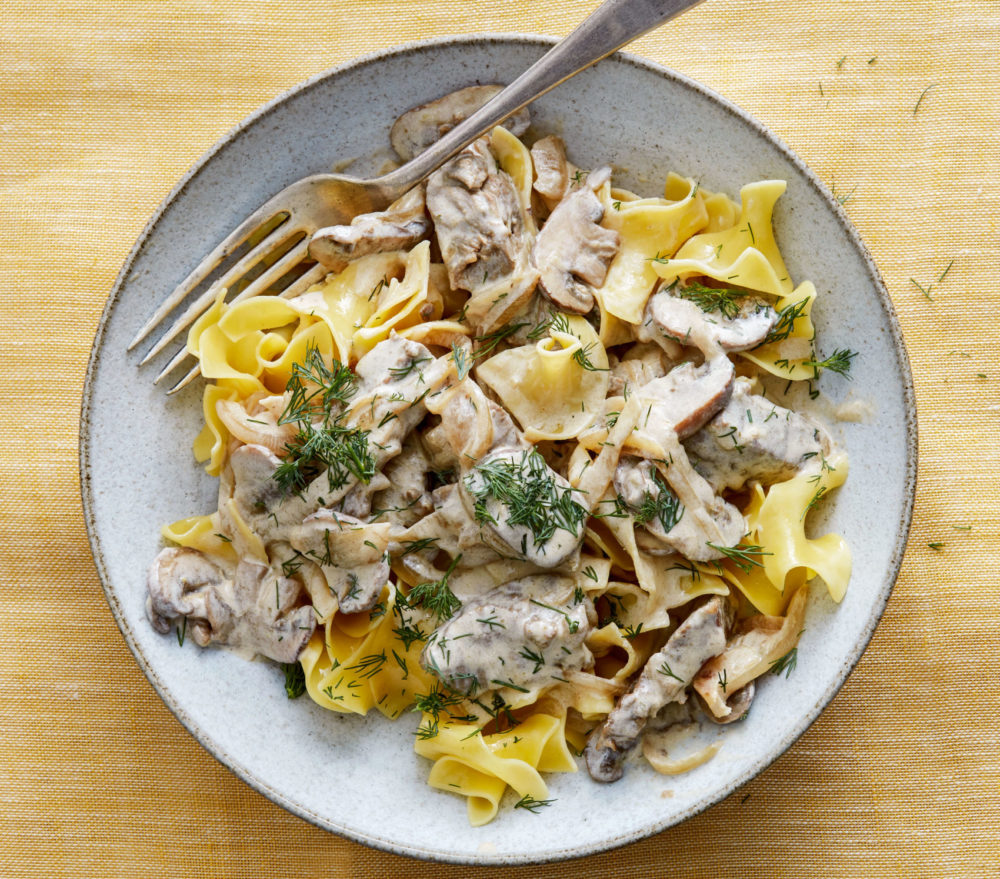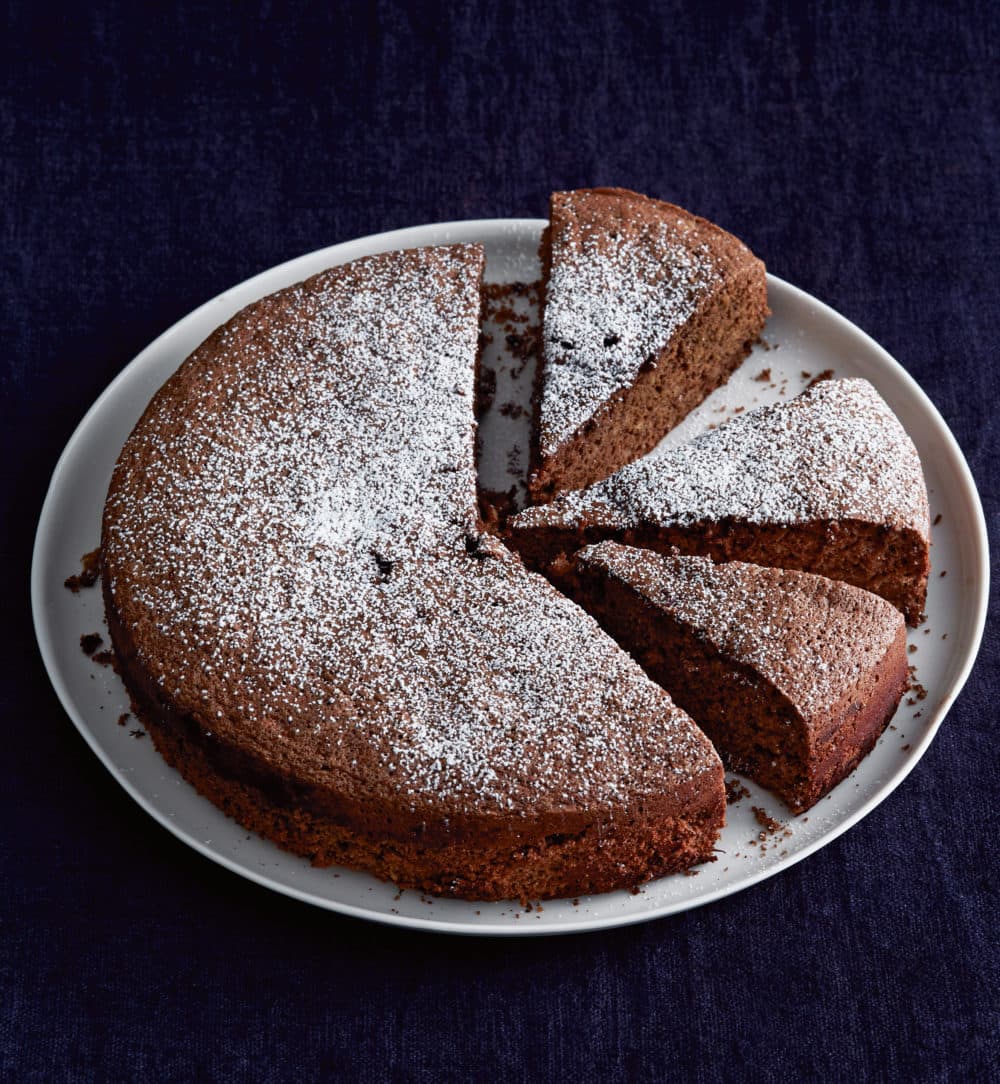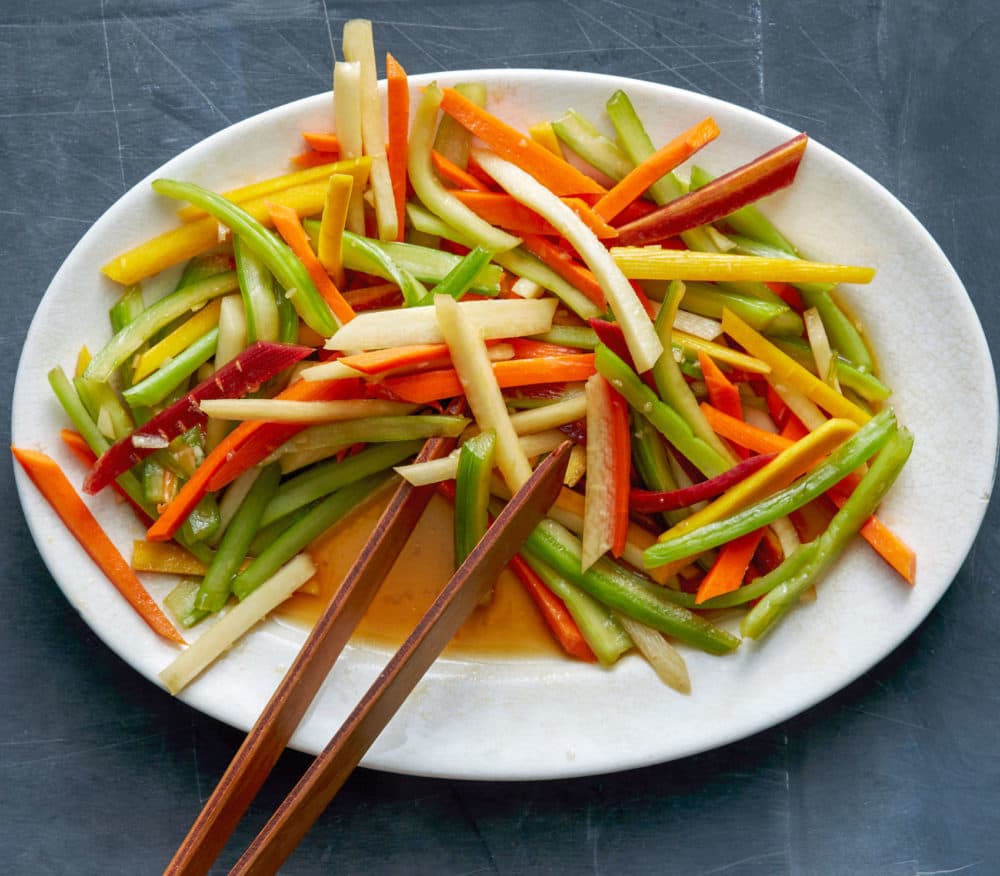Advertisement
Mark Bittman's Iconic Cookbook Reflects Sustainability, Flexibility 20 Years Later

If you're a cook, you're likely in possession of a broken-spined, batter-stained, dog-eared copy of Mark Bittman's cookbook, "How To Cook Everything."
If you're new to cooking, or are ready for a new copy, Bittman has released a 20th-anniversary edition of the iconic cookbook — updated with a focus on flexibility and sustainability.
One of the basic tenets of his book is that once you learn a technique, you can use that technique on any type of food. For instance, if you figure out how to bread and fry eggplant, you can bread and fry any vegetable.
“You might need a little tweaking here and there … but it's not like you need to relearn each individual food and each individual technique every time you cook,” Bittman says. “That once you have the fundamentals down, everything else is kind of a variation.”
He says success in the kitchen comes down to three things: “knowing what to do, having the stuff on hand, and then shopping for something fresh and wonderful.”
“The key is really getting good ingredients and not screwing them up,” Bittman says.
Interview Highlights
On updating his cookbook to focus on flexibility and sustainability
“I like to think over the years I've learned how to better and better transmit that information about how simple cooking is, and how the way to cook is to go find good ingredients and not screw them up and so on. Sustainability is not something we really talked about 20 years ago, and certainly not 40, 50 years ago, but now it's obviously an issue and when you talk about meat-eating, for example, it's not just a question of is meat good for you? It's a question of should you be eating as much meat as most Americans do? And the answer's no. So I've tried to adjust my personal cooking, and then the way that I talk about and write about cooking to that notion.”
On the idea of eating rice and beans at least once a week
“I almost literally eat whole grains and legumes for lunch every day, and they're never the same. Beans can kind of be as simple as sort of soupy black beans with cumin and garlic, maybe a little chopped onion, South American Caribbean style, or you can do with an elaborate spice mix and maybe some mustard seeds fried in oil at the end. And often I do things that are simple as beans with garlic and rosemary, lemon and olive oil. You think of a culture, everybody cooks legumes. Legumes are the most important protein source in the world. Honestly, you could probably do a thousand variations on basic bean recipes. I don't do that. I think there are 20, but that's plenty.”
Advertisement
On what’s important to have in your pantry
“Don't put a number on it. When you start cooking, you need some equipment and you need some stuff in the pantry. I mean, you need olive oil, you need soy sauce, you need vinegar, you need garlic. You need those kinds of things on hand all the time. But since many of those things keep more or less forever or let's say keep for a year, as you need them, you accumulate them. So you can have five or 10 different kinds of dried beans in the pantry at the same time and the same number of grains, and you can have anchovies and capers and dried shrimp and bonito flakes ... and all of those things because they just keep and then you have the option.”
On how to stay flexible when cooking
“There's a joke that some old food writer friends and I have that there are really only 10 recipes in the world — and in a way it's true. Going back to that eggplant example, if you can fry something, you can pretty much fry anything. If you can roast something, you know once you get these basics down, once you learn how to judge doneness, it's all just kind of playing with the possibilities. My job is to just show people how to do the basics and then give them ideas for the possibilities.”
On why he wants to change the way we talk about food
“I think we're starting to talk about food in the right way. Food is as important to humans as anything. I mean that is literally true. You can't say that about too many things. So to talk about our favorite restaurants is not the same thing as to talk about where food comes from and how it's produced. And I think where food comes from and how it's produced is really, really critical. And we are seeing that. That agriculture has an impact on both climate and also on our diets. We can only eat what we're provided with. We can only eat what's grown, and if what's grown is corn for junk food and for animal feed and for ethanol, well then we're going to drive cars and eat a lot of junky meat and a lot of junky food, and there's a better way to do these things and that should be part of the conversation.
“We are doing ourselves a disservice, I mean, I don't want to be too preachy, but until we start raising kids appreciating what real food is and appreciating where it comes from and how to put it together, we're not going to have generations of adults that aren't hung up on food. Right now, there isn't a person who isn't listening to this, including you and me, who doesn't know how hard it is to change the way they eat because we've all been raised with substandard food habits, and then we grow up and we say, 'Gee, I should be eating less meat, I should be eating more vegetables.' ... And it's not that easy to change. All I can do is try to make those things easier.”
Karyn Miller-Medzon produced and edited this interview for broadcast with Kathleen McKenna. Samantha Raphelson adapted it for the web.
Recipes From "How To Cook Everything"
By Mark Bittman
Beef Stroganoff with Mushrooms

MAKES 4 TO 6 SERVINGS
I’m keeping this classic quick braise in this edition because it’s easy and people love it—when it’s good. It’s one time you don’t want to brown the meat before adding the liquid. Serve this over buttered egg noodles or white rice, or with soft, eggy bread like challah or brioche. Other meats you can use: boneless veal or pork shoulder; veal round.
- 3 tablespoons butter
- 1 large onion, sliced
- 8 ounces cremini mushrooms, trimmed and sliced
- Salt and pepper
- 1 ½ pounds beef tenderloin or sirloin, cut into 1-inch pieces
- 1 tablespoon Dijon mustard
- 1 cup beef or chicken stock (to make your own, see below)
- 1 cup sour cream
- Chopped fresh dill or parsley for garnish
- Put the butter in a large skillet over medium heat. When it foams, add the onions and mushrooms and sprinkle with salt and pepper. Cook, stirring occasionally, until they are soft but not browned, 10 to 15 minutes.
- Add the beef and cook, stirring, for just a minute. Add the mustard and stock and adjust the heat so the liquid bubbles steadily. Cook, stirring occasionally until the meat is just cooked through but still tender, about 5 minutes.
- Add the sour cream and stir until it heats through and forms a sauce, careful not to let it come to a boil. Taste, adjust the seasoning, garnish with dill, and serve.
Quickest Chicken Stock
MAKES 12 CUPS
- One 3-to 4-pound chicken
- 1 large onion, roughly chopped (don’t bother to peel)
- 1 large carrot, roughly chopped
- 1 celery stalk, roughly chopped
- 1 bay leaf
- Several sprigs fresh parsley (optional)
- Salt and pepper
- Cut the chicken up, if you like; it will speed cooking. Put the chicken, onion, carrot, celery, bay leaf, and parsley in a large pot, add 14 cups water, and turn the heat to high.
- Bring just to a boil, then lower the heat so the liquid sends up a few bubbles at a time. Cook, skimming any foam that accumulates, until the chicken is cooked through, 30 to 60 minutes, depending on the size of the chicken and whether it’s cut up or whole.
- Transfer the chicken to a bowl with a large fork. Cool the stock slightly, then strain, pressing on the solids to extract more liquid. Discard the remaining solids. When the chicken is cool enough to handle, remove the skin, remove the meat from the bones (discard the skin and bones), and store the meat to use in other recipes. Sprinkle with salt and pepper and taste and adjust the seasoning. Skim off any fat and use the stock immediately. Or let cool, refrigerate, skim off any hardened fat from the surface, and use within 3 days or freeze for up to 3 months.
Time: 40 to 60 minutes
Full-On Chicken, Turkey, or Duck Stock
Turkey or duck can be substituted for some or all of the chicken. And be aware that intensity of flavor can get expensive: Substitute 3 to 4 pounds chicken, turkey, or duck parts, preferably wings, thighs, and legs, for the whole chicken. Cook for at least 1 hour and up to 4 hours. Strain out and discard all the solids after pressing down on them.
Beef, Pork, Lamb, or Veal Stock
MAKES ABOUT 14 CUPS
- 3 to 4 pounds meaty beef, pork, lamb, or veal bones, like shank, shin, tail, or short ribs
- 2 onions, chopped (don’t bother to peel)
- 2 carrots, copped
- 2 celery stalks, chopped
- 1 bay leaf
- At least 10 sprigs fresh parsley (optional)
- 1 teaspoon salt, plus more to taste
- 3 whole cloves
- 10 peppercorns
- Rinse the bones well under cold running water, then put them in a large stockpot. Add the onions, carrots, celery, bay leaf, parsley if you’re using it, cloves and peppercorns. Add about 16 cups water, enough to cover by a couple of inches.
- Bring just to a boil, then partially cover and adjust the heat so the mixture just barely bubbles. Cook, skimming off any foam that accumulates at the top, until the meat falls from the bones and the bones separate from one another, 2 to 3 hours.
- Cool slightly, then strain, pressing on the solids to extract as much liquid as possible. Skim off any fat and use the stock immediately. Or let cool, refrigerate, skim off any hardened fat from the surface, and use within 4 or 5 days or freeze for up to 3 months.
Time: At least 3 hours, largely unattended
Rich Chocolate Torte

MAKES 10 TO 12 SERVINGS
For those of you keen on molten cakes (I’m ambivalent, to be honest) try this simple alternative. Then either dust it with confectioner’s sugar, or gussy it up. Some of the best ways: Top with Whipped Cream (see below) or serve with raspberry purée (see below) and/or Vanilla Custard Sauce (see below) or Vanilla Custard Ice Cream (see below). Or drizzle with Chocolate Glaze (see below). To go truly decadent split the cake into two layers, then fill and frost with Chocolate Ganache or Glaze (see below).
- Butter for greasing
- 1 cup all-purpose flour, plus more for the pan
- Cocoa powder, for dusting the pan (optional)
- ½ teaspoon salt
- 6 to 7 ounces dark chocolate (at least 70% cacao)
- 5 eggs
- 2 teaspoons vanilla extract
- ¾ cup granulated sugar
- Confectioners’ sugar for garnish (optional)
- Heat the oven to 350°F. Butter a 9-inch layer cake pan. Cover the bottom with a circle of wax or parchment paper and butter the paper. Use a sieve to dust the pan with flour or cocoa powder, invert the pan over the sink, and tap to remove any excess.
- Whisk the flour and salt together in a medium bowl. Melt the chocolate with ½ cup water in a double boiler, stirring occasionally. Remove from the heat and let cool.
- In a large bowl, use an electric mixer to beat the eggs and vanilla until light. Gradually add the sugar, continuing to beat until the mixture is
- Pour the batter into the prepared pan. Bake until a toothpick inserted into the center of the cake comes out clean or with a few moist crumbs, 30 to 40 minutes. Let the cake cool in the pan for 5 minutes, then invert onto a wire rack to finish cooling. Dust the cake with confectioners’ sugar if you like and serve small slices.
Time: About 1 ¼ hours, plus time to cool
Chocolate-Hazelnut Torte
Substitute ¼ cup finely ground hazelnuts for ¼ cup of the flour. Stir ½ cup lightly toasted chopped hazelnuts into the batter just before pouring into the pan.
Whipped Cream
MAKES ABOUT 2 CUPS, ENOUGH FOR 4 SERVINGS
- 1 cup heavy cream
- Up to ¼ cup sugar
- Flavoring (optional; see below)
- In a large bowl, use a whisk or electric mixer to beat the cream to soft or stiff peaks, as desired (see the illustrations). If you're sweetening it, when soft peaks form, start sprinkling in the sugar 1 tablespoon at a time.
- Fold in flavorings if you like and serve immediately. Or cover and refrigerate for up to 2 hours. If it starts to separate, whisk it lightly until it comes together again.
Time: 5 minutes
8 Ways to Flavor Whipped Cream:
- Scrape the seeds from half a vanilla bean into the cream, or use 1 teaspoon good-quality vanilla extract.
- Use honey instead of sugar.
- Sprinkle and fold in ground cardamom, cinnamon, freshly grated nutmeg, or any finely ground sweet spice.
- Add 1 to 2 tablespoons bourbon, brandy, Kahlúa, Grand Marnier, framboise, amaretto, or other liqueur.
- Add about ½ teaspoon grated citrus zest.
- Add ½ teaspoon finely grated or very finely minced fresh ginger.
- Add a tablespoon or 2 sour cream, or crème fraiche or mascarpone, which will be tangier or thicker, respectively.
- Add 1 to 2 teaspoons rose water or orange blossom water.
Marinated Celery and Carrots, Chinese Style

MAKES 4 APPETIZER OR SIDE-DISH SERVINGS
An easy and ultra-savory, crunchy little nibble. Next time you make this recipe, you’ll want to double it. Or try substituting summer squash, daikon radish, or any other vegetables you like raw. See the first variation for more ideas.
- 4 celery stalks
- 4 carrots
- 1 teaspoon salt
- 1 tablespoon sugar
- 2 tablespoons sesame oil
- 2 tablespoons soy sauce
- 2 teaspoons vinegar (preferably rice or cider vinegar)
- 1 clove garlic, chopped
- Pinch cayenne (optional)
- Cut the celery and carrots into 2-inch lengths, then into rough matchsticks. Mix with the salt and let sit for at least 10 minutes and up to an hour while you whisk together the remaining ingredients.
- Rinse, drain, and pat the vegetables dry, then toss with the dressing. Serve or marinate in the refrigerator for up to a day and serve chilled or at room temperature.
Time: 10 minutes, plus time to marinate
Any Sturdy Vegetable, Chinese Style
Anything you don’t want to eat raw works too: Cut 1 pound vegetables like broccoli or snow peas into bite-sized pieces. Instead of salting the vegetables in Step 1, whisk the salt into the dressing. Parboil and shock the vegetables. Use the same dressing.
“Carpaccio”-Style Vegetables
Especially impressive fanned out on a large platter: Omit the sesame oil, soy sauce, and vinegar. Peel 1 pound sturdy vegetables like carrots, kohlrabi, turnip, cauliflower, summer squash, celery, and/or beets. Slice the vegetables crosswise as thin as possible (a mandoline or food processor slicing blade is perfect for this). Toss with the salt and let marinate for at least 10 minutes or up to an hour. Scatter the vegetables in a thin layer, drizzle with olive oil and fresh lemon juice.
Excerpted from HOW TO COOK EVERYTHING—COMPLETELY REVISED TWENTIETH ANNIVERSARY EDITION: SIMPLE RECIPES FOR GREAT FOOD © by Mark Bittman. Photography © 2019 by Aya Brackett. Reproduced by permission of Houghton Mifflin Harcourt. All rights reserved.
This segment aired on October 8, 2019.
